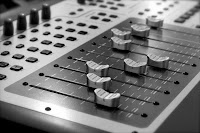
One of the hardest things for an inexperienced mixer to determine is when a mix is finished. In fact, engineers new to mixing may think a mix is ready in an hour when a pro might take considerably longer, but the quality would be better as well. This excerpt from
The Audio Mixing Bootcamp looks just how you'll know when your mix is ready for the world.
"While many beginning mixers will fly through a mix and be finished in an hour, most mix veterans take a lot longer than that to get a mix together. As you’ve seen from the previous chapters, a fair amount of experimentation is required to find the parameter settings for EQ, compression and effects that work with the track.
While rough mixes are done very fast by nature (they may only take a couple of passes through the song to get together), and you might occasionally get lucky with a quick mix, most veteran mixers usually figure it takes a five to twelve hour day to mix a song. Many mixers like to have an extra half-day to tweak things with a fresh ear, but many big-name, big-budget projects can take weeks of multiple mixes to sculpt it just right.
Of course, if all you have is time, then you can mix a song way beyond its peak (the final mix for Michael Jackson’s hit “Billy Jean” was #2 out of 99), so it’s best to have a few guidelines as to when it might be finished.
How To Know When Your Mix Is Finished
You can consider a mix finished when the following occur:
- You can feel the groove. Whatever element supplies the groove, it has to be emphasized so that the listener can feel it.
- Every instrument or vocal can be clearly heard. If an instrument or vocal is unintentionally masked or covered by another instrument or vocal, then your mix isn’t finished.
- Every lyric and every note of every line or solo must be clearly heard. Each note should be crystal clear. Tweak your fader automation to help this out.
- Be sure the mix is punchy. This is usually a function of the bass and drum EQ and compression.
- The mix has an interesting element. Make sure the most important element of the song is obvious to the listener.
- Be sure your mix sounds good when you play it against other songs that you like. Consider it a job well done when this happens.
If time is not a problem, do as many versions as you can until you feel satisfied with your creation. Mixing takes experience so the more time you put in, the better you get at it.
Am I Finished Yet?
A) Listen to the mix. Is the groove obvious? Can you feel it in the mix?
B) Listen to the mix. Can every instrument be clearly heard?
C) Listen to the mix but concentrate on the vocal. Can every lyric be heard?
D) Is the mix punchy?
E) Listen to the mix. What grabs your attention?
F) Play your mix and then play your favorite song. If both songs were played on the radio back to back, would your mix stand up?"
To read additional excerpts from
The Audio Mixing Bootcamp and other books,
go to BobbyOwsinski.com.
----------------------------------


